11 Best Cuts Of Beef For Fajitas
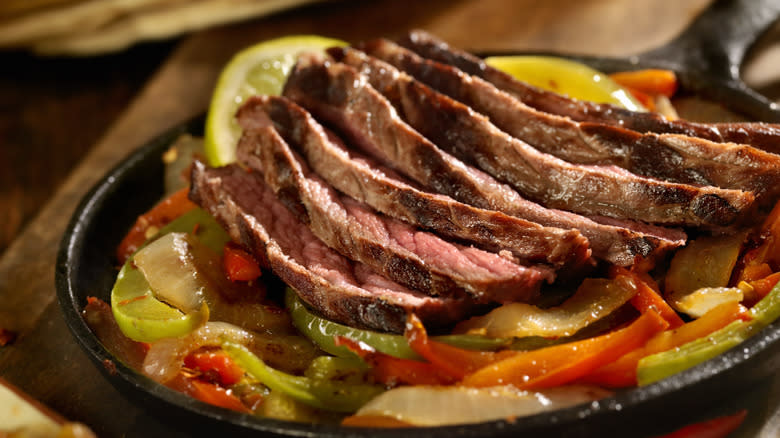
Who's head isn't turned by the sizzle of a fresh plate of fajitas snaking their way through the crowd at your local Mexican restaurant? Savory and satisfying, this Tex-Mex staple is a build-your-own adventure most culinary travelers are happy to embark upon. Arguably, the king of this delicious domain is the steak fajita — meaty slices of rich beef seasoned to perfection with a secret blend of spices for just the right amount of tender kick.
Born of necessity, the steak fajita as we know it was likely the invention of Mexican vaqueros and ranch hands working on Texas cattle ranches in the 1930s. The cowboys were often stuck with lesser cuts of beef, which they found to be perfectly delicious when seared over hot coals and stuffed into tortillas for an equally filling and, more importantly, portable meal.
Restaurant-style sizzling steak fajitas are easy enough to whip up at home if you have the know-how. To crank out this cowboy classic, you just need a quality steak, a hot grill, and a touch of seasoning. While simple solutions like salt, pepper, and garlic are perfectly fine, try upping the flavor ante with sun-dried chile powder or sweeten your steak fajitas with a bit of brown sugar. Either way, be sure to cook that steak hot and fast to get that deliciously authentic char.
To perfect the homemade fajita, you'll need the right steak. So, how do you know which beef is a cut above? Here's a tasty place to start.
Read more: The Most Popular Cuts Of Steak Ranked Worst To Best
Skirt Steak
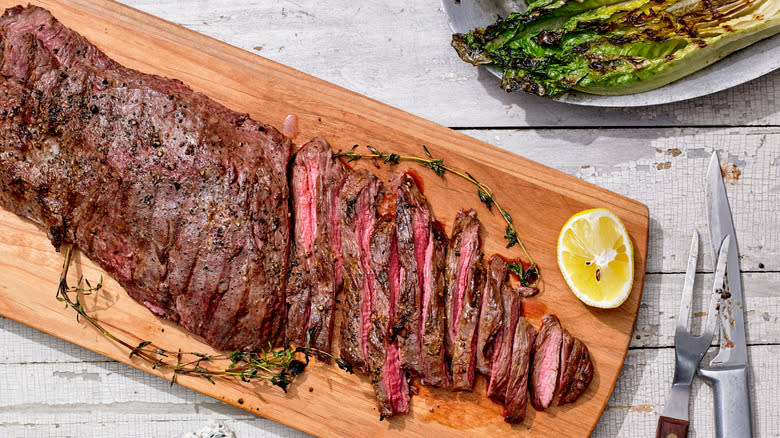
Probably the most traditional cut for classic fajitas, skirt steak is an affordable option with great beefy flavor. Cut from just under the ribs, skirt steak is a fairly well-used muscle that can be tough if not treated properly. Luckily, a blend of marinating and high heat can easily render this meaty morsel fajita-worthy.
When shopping for your perfect skirt steak, the cut you're most likely to come across is the inner skirt steak. Yes, it turns out that not all cuts are created equal, and there is, in fact, a difference between an inside and outside skirt steak. While both cuts lend themselves to quick cooking over high heat, the outside skirt steak tends to be much more tender than the more highly utilized inner cut. The outside cut comes from the cow's diaphragm, which has far less tough connective tissue than its counterpart. Either cut would make a mouthwatering fajita, but the outside cut is much harder to source and pricer due to its natural tenderness. For your next fajita night, you can just stick to the affordable inner skirt steak.
For perfectly tender steak fajitas, the secret is in the slice. To ensure your skirt steak doesn't turn out chewy, cut the meat against the grain. All this means is that you're cutting the beef's tough fibers into shorter, easier-to-chew pieces. Simply look for the thin lines running across the steak and slice through instead of along the fibers for the most tender fajita meat.
Flank Steak
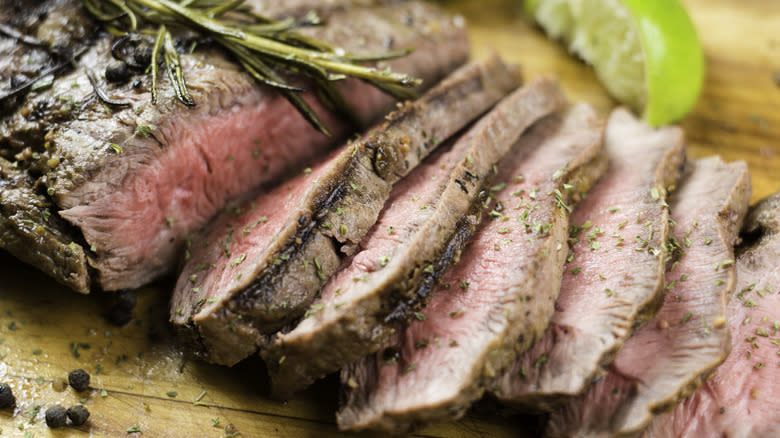
Another top choice for meaty fajitas, flank steak is a leaner cut than skirt steak and requires a bit longer cooking time but provides just as much beefy flavor. Flank steak is sourced from a steer's abdomen just under the loin, which means tight muscle fibers with less marbling to naturally tenderize the final product. To avoid a tough and tasteless fate, flank steak needs a little R&R in the form of an acidic marinade. Once tenderized, the affordable cut cooks quickly, making it a top choice for weeknight steak fajitas.
Flank steak's tight muscular makeup means that it doesn't hold onto marinades quite as well as skirt steak, which makes the leaner cut an ideal candidate for a flavorful rub instead. Whip up your own homemade fajita seasoning with spices you likely already have on hand, like smoked paprika, chili powder, and cumin. For an acidic bite, squeeze some fresh lime juice over the meat before applying the rub. This not only provides an extra flavor boost for your fajitas, but the acid in the lime juice will help to tenderize the meat before you toss it on the grill.
Be sure to allow your beef ample time to rest once it comes off the grill. Letting the juices redistribute through the meat is an essential step to avoiding a dry final result. And just like with skirt steak, it's extremely important to cut flank steak against the grain to avoid super tough fajitas.
Top Round Steak
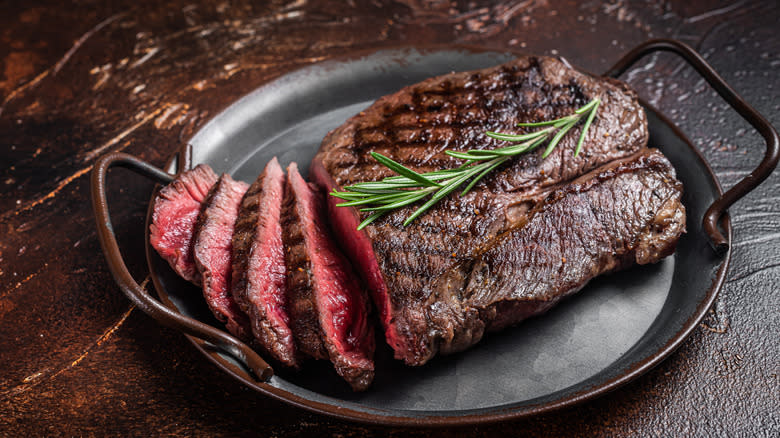
Cheap and super-lean, top round steaks are already perfectly shaped for fajitas. Their uniform thickness makes the cut easy to slice and sauté, which is why it can be found in some grocery stores pre-sliced and labeled as "fajita" or "stir-fry meat."
Cuts from the beef round primal (like top round) are typically reserved for low and slow cooking methods like stews due to their tough, muscular makeup. These cuts are sourced from the cow's back legs and rump, two areas that get a significant amount of exercise. This portion of the animal also contains quite a bit of connective tissue that can render the meat chewy if not prepared properly.
Luckily, the top round is sourced from the inside of the hind legs, an area that contains mostly cartilage-free muscle, resulting in a steak that can easily be tenderized. To use this cut for fajitas, you'll want to pound it with a meat mallet and slice it thinly against the grain before cooking to minimize the amount of time it spends over the heat. Simply season, sauté quickly over high heat, and allow the beef to rest for a few minutes before stuffing it into warm tortillas.
Flat Iron Steak
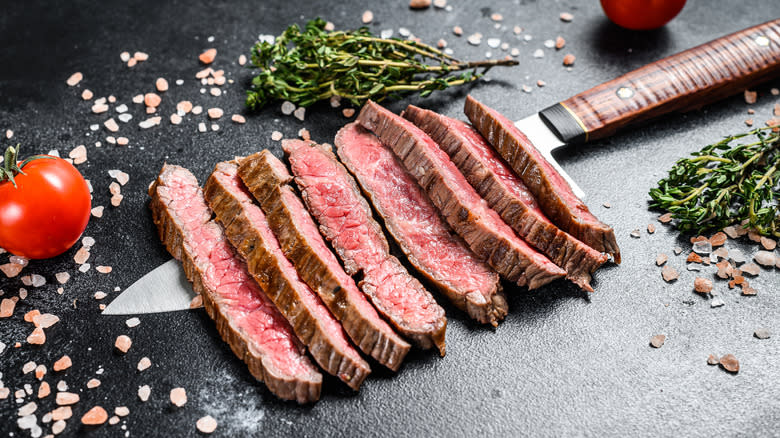
Thanks to a combination of muscle-rich tissue and ample marbling, flat iron steak has the potential to be a tender addition to your next batch of fajitas. Cut from the area of the cow where the neck connects to the shoulder (also known as the chuck); flat iron steak can have quite a bit of connective tissue, which isn't a problem as long as you know how to treat your beef.
A well-butchered flat iron steak should be free from sinew — that's one part of the beef you don't want to eat. If you're unsure about your specimen, you can simply ask your butcher to remove it for you. Your newly sinew-free steak lends itself well to grilling up for fajitas, albeit with one unique method to add extra flavor. Instead of marinating your meat before you throw it on the heat, try utilizing a reverse marinade. Exactly what it sounds like, this technique involves whipping up an acid-rich sauce that you toss the meat in just after it finishes cooking. This method allows bright fajita-friendly flavors like lime and cilantro to retain the freshness that can get lost with high-heat grilling.
Thanks to its naturally thin nature, flat iron steak only needs a few minutes to sear on each side to reach a mouthwatering medium-rare. Let the meat rest for a few minutes before slicing against the grain and drizzling with your reverse marinade. Pack the tender beef into tortillas with freshly sautéed veggies for simple steak fajitas.
Hanger Steak
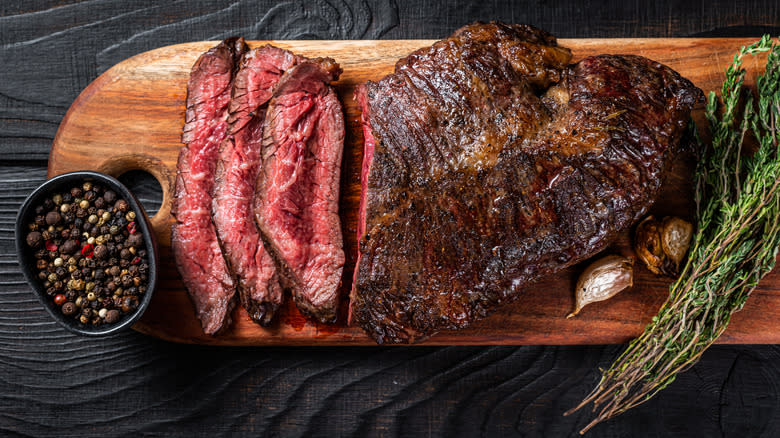
Sourced from a lesser-used area on the cow's diaphragm, hanger steak's rich marbling makes it a quick and easy cut to cook — if you can find it. Only one hanger steak can be sourced from a single cow, making it a hard-to-find cut not often stocked on grocery store shelves. Once referred to as "the butcher's secret," hanger steak's high quality and lower demand make it a prime choice for elevated fajitas.
The once-unknown cut has exploded in popularity in recent years due to its appearance on trendy restaurant menus, but the hanger steak still provides great bang for your buck. You'll want to head to a butcher over the grocery store for this one, but the extra effort is worth it for a perfectly trimmed steak free of silver skin and sinew.
Thanks to a soft, loose texture, hanger steak works like a flavor sponge, soaking up mouthwatering marinades and fajita-friendly dry rubs with ease. To take this cheaper steak up a notch, try marinating the meat in Coca-Cola. As acidic as lemon juice, the classic soda helps to break down tougher proteins while also imbuing the beef with flavor and ensuring a gorgeous caramelized crust thanks to its high sugar content.
Its thinness makes it a quick cut to cook up, too. The key to cooking hanger steak is to aim for medium — served too rare or too well-done, the meat will be far too chewy to consume in fajita form.
Top Sirloin Steak
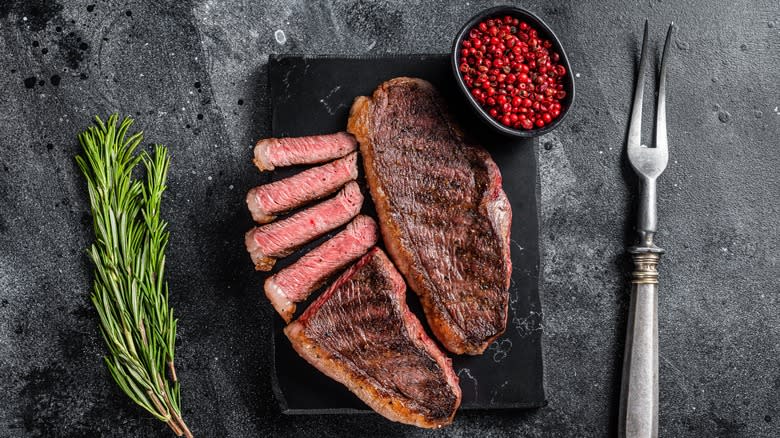
Lean and meaty top sirloin is one of the best-valued and most popular cuts of steak out there. In fact, the steak is so beloved that there's a fanciful legend regarding how sirloin got its name. Supposedly, King Henry VIII loved the cut so much that he decided to knight it, dubbing the beef "Sir Loin." There are other versions of this tale starring King Charles II and James I, though all are unlikely to have actually happened. Regardless of how the beef got its title, it remains a regal choice to this day.
Sourced from the cow's hindquarters between the last rib and the hip bone, the sirloin primal is divided into top and bottom portions before being sold at your local grocery store. The tougher bottom sirloin is typically reserved for ground beef, while the top sirloin is typically cut into steaks. Since it comes from a lesser-used part of the animal, the top-sourced beef enjoys thorough marbling that results in a tender and juicy product when simply grilled.
When cooking up top sirloin for fajitas, simplicity is key. Thanks to the cut's rich marbling, you just need a good sprinkling of seasoning and a quick sear on the grill to achieve mouthwatering results. As with any steak, let the meat rest before slicing thinly and topping with a rainbow of onions and bell peppers.
Tri-Tip Steak
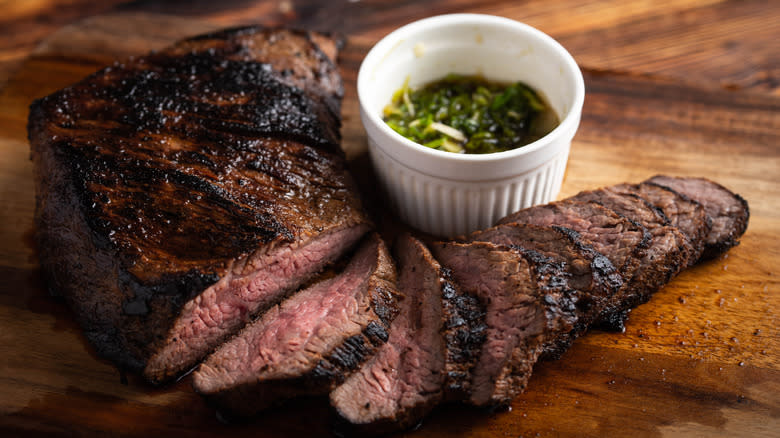
Not all bits of the bottom sirloin are relegated to ground beef status. California cookout darling tri-tip steak develops delicious flavor when charcoal-grilled, a method that lends itself well to simple fajitas.
The aptly named triangular-shaped cut is relatively affordable due to its smaller size and super-lean muscular makeup, though it does contain just enough marbling to render the beef tender when cooked quickly over high heat. The smokiness from the grill imparts just enough flavor to give tri-tip an authentically fajita-friendly flavor, though a nice dry rub and a generous sprinkling of salt couldn't hurt. In fact, a dry rub of salt, black pepper, and garlic salt is the traditional way tri-tip was seasoned in the early days of Santa Maria-style California barbecue. It was along California's central coast that the tri-tip took off in popularity for its delectably grillable quality; hence its popularity as a West Coast cut to this day
When it comes to cooking, you won't want to take your tri-tip steak much beyond medium rare. The lack of fat in the meat means that tri-tip isn't very forgiving if overcooked, so it's best to err on the side of rare to enjoy pleasantly tender fajitas.
New York Strip Steak
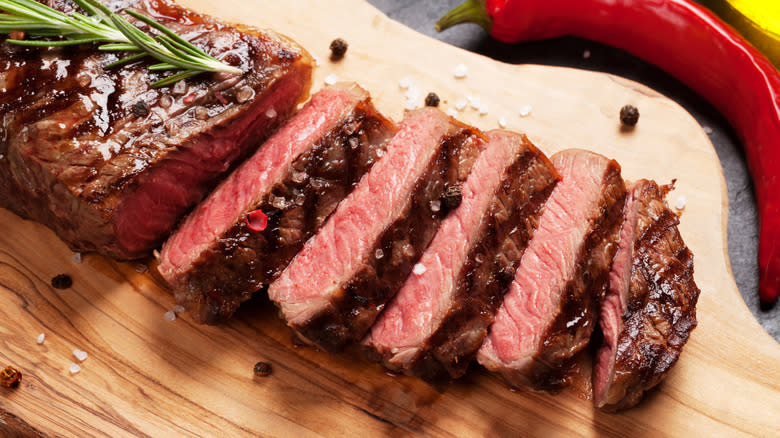
If you're looking to go all out with your next fajita night, New York strip is the key to unlocking the most flavorful steak-filled tortillas. Among the most affordable of the prime cuts, New York strip delivers on texture and flavor with minimal effort. Just be sure not to overcook the pricer piece of beef.
Sourced from the shorter side of the loin primal, this cut enjoys richer marbling and a looser muscle structure thanks to its lesser-used spot on the cow — in short, it's a tender and flavorful piece of beef that's one of the absolute best cuts of steak to grill. While it doesn't feature quite as much marbling as a ribeye and isn't as tender as filet mignon, its super beefy flavor helps to make up for any fatty shortcomings.
All it takes to render a New York strip fajita-worthy is a healthy coating of olive oil (to make up for any missing fat) and a sprinkling of salt, pepper, and any other Tex-Mex-inspired seasonings you might desire. Be sure to add a little acid to your final fajita to help cut through the beefy richness of that perfectly grilled New York strip.
Teres Major

Looking for a more affordable alternative to pricey filet mignon? Then it's time you were introduced to teres major. This harder-to-find cut delivers an equally tender bite at a much more digestible and fajita-friendly price point. The beefy cut stands up well to marinades, making it a flavorful option for a fajita upgrade.
Cut from the lean shoulder of the cow, the lesser-known teres major enjoys all the tenderness of a filet mignon without the hefty price tag. The heavily used muscle gets much more blood flow than the filet, which leads to a richer, meatier flavor. While you may not be able to find this more unusual cut at the grocery store, an experienced local butcher should have no problem sourcing it for you — just trust that the final product is worth the extra effort.
The high-quality teres major doesn't have the tough, sinewy fibers of other less expensive cuts, meaning that it doesn't require a lot of extra attention before hitting the grill. Simple seasonings, a quick sear, and a proper rest are really all you need to enjoy some of the most flavorful fajita fillings you've ever tasted. One thing to note is that the teres major requires a significantly longer post-cooking rest period than other steaks, about twice as long in fact. Let the meat rest for around 15 minutes before slicing.
Merlot Steak
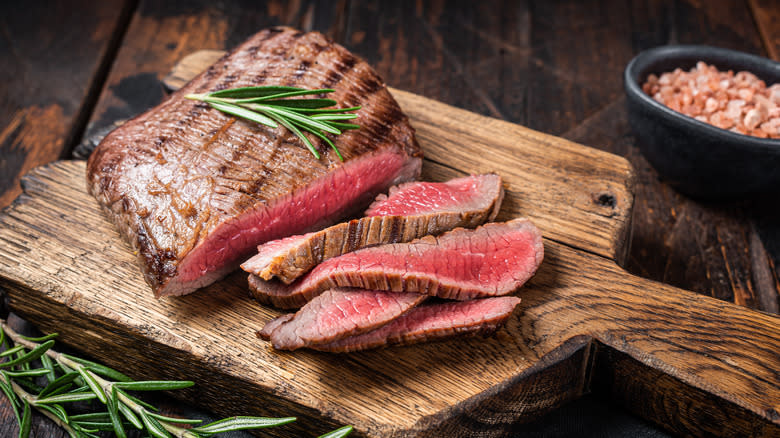
Similar to flank steak, the less well-known merlot steak has a finer texture and more marbling, which makes it a more tender alternative to its more familiar counterpart. Sourced from the round primal near the heel muscle of the cow (between the shank and the bottom round), the merlot steak's thin, flat shape makes it a prime candidate for a quick sear over high heat — the magic combination for mouthwatering fajitas.
This fairly new cut is the product of meaty necessity. During times of economic hardship, people stop buying more expensive cuts. The Beef Innovations Group was born out of a need to get more affordable steaks out of a cow instead of turning the whole animal into ground beef. Out of this project came value cuts like the Denver cut, the petite tender, and the merlot steak.
While you'll need to head to the butcher shop to source this piece of beef, it's still one of the most affordable cuts of meat on the market for texture and flavor. When it comes to cooking, just treat the beef as if it were a flank steak. You could marinate it to impart a little extra flavor, but the naturally tender cut doesn't require any extra TLC to render it fajita-worthy.
Sear the steak over high heat for just a few minutes per side until it reaches medium-rare to medium doneness. Since this cut lacks a significant source of fat, undercooking it will result in a chewy final product.
Bavette Steak
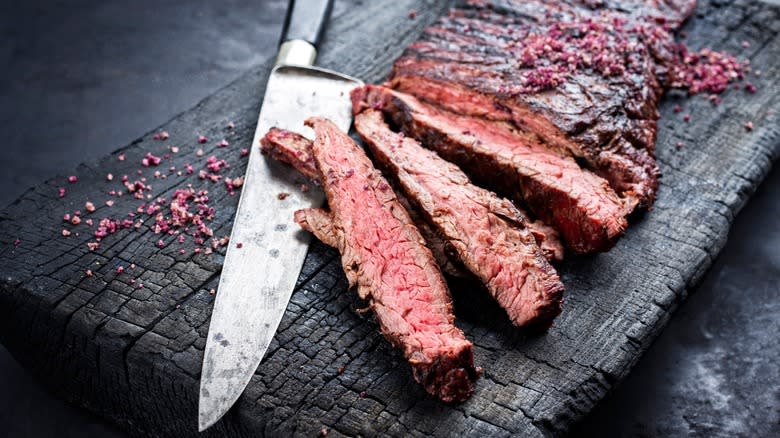
Sometimes referred to as "the butcher's cut" for its under-the-radar reputation, bavette or flap steak boasts a fairly high-fat content that delivers delicious beefy flavor when seasoned simply and cooked quickly, making it an ideal fajita night hero. This more affordable cut of steak is sourced from the cow's belly; hence its name — "bavette" is the French word for "bib." Its lesser-used location on the cow also gives bavette a juicy muscle-to-fat ratio that renders it more flavorful than similar cuts like skirt or flank steak.
Similar in shape to skirt steak, bavette boasts a looser muscle structure that helps protect it from the unpleasant side effects of overcooking, like jaw-tiring toughness or unpalatable chew. This signature structure also makes the steak an ideal candidate for external flavor agents since it can easily hold on to thin marinades and flaky dry rubs.
The only downside to bavette steak is that it can be difficult to source. You'll need to head to the butcher shop to secure your specimen, but the difference in flavor and texture (not to mention price) is well worth the effort. Simply seared and sliced thin, bavette might just be your new go-to cut for tender and flavorful fajitas.
Read the original article on Tasting Table.

